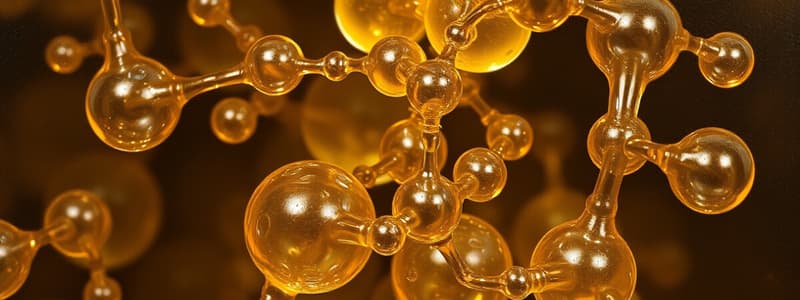Podcast
Questions and Answers
What is a lipid commonly referred to as?
What is a lipid commonly referred to as?
- Nucleic Acid
- Fat (correct)
- Carbohydrate
- Protein
What is the backbone of a lipid?
What is the backbone of a lipid?
Glycerol
What combines with glycerol to form a lipid?
What combines with glycerol to form a lipid?
Fatty Acid
What is a phosphate group?
What is a phosphate group?
What are triglycerides?
What are triglycerides?
What composes a phospholipid?
What composes a phospholipid?
What do fatty acids have in terms of structure?
What do fatty acids have in terms of structure?
What distinguishes single and double bonds?
What distinguishes single and double bonds?
Saturated fatty acids are composed entirely of double bonds in the tail.
Saturated fatty acids are composed entirely of double bonds in the tail.
Mono-unsaturated acids have one double bond in the tail.
Mono-unsaturated acids have one double bond in the tail.
Poly-unsaturated fats contain only single bonds.
Poly-unsaturated fats contain only single bonds.
What are trans-fats?
What are trans-fats?
What are cis-fats?
What are cis-fats?
What characterizes cholesterol?
What characterizes cholesterol?
Flashcards are hidden until you start studying
Study Notes
Lipids
- Lipids are commonly known as "fats" or "oils," serving essential biological roles.
Glycerol
- Glycerol, a 3-carbon molecule, acts as the backbone for lipid formation.
Fatty Acids
- Fatty acids are long, carbon-based molecules crucial for constructing lipids alongside glycerol.
Phosphate Group
- Phosphate groups consist of a phosphorus atom at their core and are key components of certain lipids.
Triglycerides
- Triglycerides are lipids made from three fatty acids and one glycerol, primarily used for lipid storage.
Phospholipids
- Phospholipids consist of two fatty acids, one glycerol, and one phosphate group, essential for building cell membranes.
Lipid Structure
- Fatty acids have a distinct structure with an organic acid "head" and a long carbon-based "tail" which dictates their functional properties.
Chemical Bonds
- Chemical bonds in fatty acids can be single or double; double bonds are considered "stronger."
Saturated Fatty Acids
- Saturated fatty acids are characterized by entirely single bonds in their tails, commonly found in animal fats; cocoa butter is derived from coconuts.
Mono-unsaturated Acids
- Mono-unsaturated fatty acids contain one double bond within the tail, with the remainder being single bonds, primarily sourced from plants and some fish.
Poly-unsaturated Fats
- Poly-unsaturated fatty acids have two or more double bonds in their structures, predominantly sourced from plants and certain fish.
Trans-fats
- Trans-fats are a type of mono-unsaturated fatty acid with a straight tail due to specific hydrogen atom placements, which are typically unhealthy.
Cis-fats
- Cis-fats have a similar chemical structure to trans-fats but exhibit bent tails due to the positioning of hydrogen atoms, generally regarded as healthier.
Cholesterol
- Cholesterol, a lipid with a long tail and four interconnected carbon rings, plays a vital role in cell membrane construction, existing in both "good" and "bad" forms within the bloodstream.
Studying That Suits You
Use AI to generate personalized quizzes and flashcards to suit your learning preferences.



